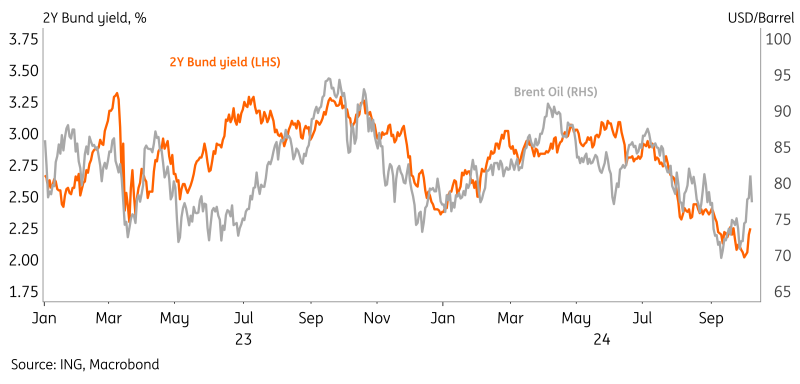Bund yields have only reacted moderately to the recent uptick in oil prices, emphasising diverging growth outlooks. Markets are convinced of an October ECB cut and oil prices would need to move considerably higher to change conviction. Among the European supra names, the EU is the only issuer that still has a notable amount to fund this year.
Pessimistic eurozone outlook keeps Bund yields from ticking higher with Oil prices
EUR rates have settled higher after that big US payrolls number last week and are likely to trade more range-bound in anticipation of the upcoming European Central Bank decision. The conviction of a 25bp cut next week is high and there will be little economic data until then that could persuade markets otherwise. Having said that, we do have oil prices to watch, which have shown quite some volatility of late. If we see more upside surprises from global growth, and at the same time headlines from the Middle East emerge, the risk of higher prices could be considerable.
Still, Bund yields reacted only moderately to the recent uptick in oil prices (see figure below), which emphasises markets’ diverging expectations between global and eurozone growth. The US labour market is showing signs of resilience (again), whilst Chinese growth expectations are improving on the back of broad stimulus measures, helping oil prices to go higher. The potential bright spots for the eurozone are more difficult to see and given growth concerns are getting more attention of late than inflation, the front end of the Bund curve is likely to remain anchored for now.
Whilst the ECB did mention the decline in oil prices as a supporting factor in its decision-making earlier, we would need to see a lot more to convince markets that an October cut may not be as obvious as priced in. Also on Tuesday various ECB speakers, including the known hawk Nagel, hinted at a willingness to cut in October. Nevertheless, the current pricing of 24bp for a cut may be stretched and a sudden push higher by oil could challenge that positioning.
EU to remain prominent in primary markets even after Tuesday's larger deal
The EU issued €11bn via the syndicated reopening of two bond lines, €5bn in a 3y and €6bn in a 15y. Investor appetite looked healthy with a combined book of €166bn and in the end the size of the transaction exceeded market expectations, and was also larger than the September deal.
Among the European supra names EU, ESM, EFSF and EIB, the EU is the only issuer that still has a notable amount to fund this year. With close to €118bn issued, slightly more than €22bn remains to reach the indicated target of €140bn for 2024. ESM and EFSF have completed their funding for the year, and EIB said its 5Y EUR bond issued last week was the last EUR benchmark for the year with close to €62bn of its €65bn funding target reached.
In terms of spreads, the valuations of the sector versus swaps in the 10y area are still around 5-6bp cheaper versus the end of August, but there has been some stabilisation since the beginning of this month.
Recent uptick in Oil prices did not find its way to Bund yields
Read the original analysis: Rates spark: Bunds relatively detached from Oil price moves
Content disclaimer: This publication has been prepared by ING solely for information purposes irrespective of a particular user's means, financial situation or investment objectives. The information does not constitute investment recommendation, and nor is it investment, legal or tax advice or an offer or solicitation to purchase or sell any financial instrument. Read more here: https://think.ing.com/content-disclaimer/
Recommended Content
Editors’ Picks

EUR/USD extends recovery beyond 1.0400 amid Wall Street's turnaround
EUR/USD extends its recovery beyond 1.0400, helped by the better performance of Wall Street and softer-than-anticipated United States PCE inflation. Profit-taking ahead of the winter holidays also takes its toll.

GBP/USD nears 1.2600 on renewed USD weakness
GBP/USD extends its rebound from multi-month lows and approaches 1.2600. The US Dollar stays on the back foot after softer-than-expected PCE inflation data, helping the pair edge higher. Nevertheless, GBP/USD remains on track to end the week in negative territory.

Gold rises above $2,620 as US yields edge lower
Gold extends its daily rebound and trades above $2,620 on Friday. The benchmark 10-year US Treasury bond yield declines toward 4.5% following the PCE inflation data for November, helping XAU/USD stretch higher in the American session.

Bitcoin crashes to $96,000, altcoins bleed: Top trades for sidelined buyers
Bitcoin (BTC) slipped under the $100,000 milestone and touched the $96,000 level briefly on Friday, a sharp decline that has also hit hard prices of other altcoins and particularly meme coins.

Bank of England stays on hold, but a dovish front is building
Bank of England rates were maintained at 4.75% today, in line with expectations. However, the 6-3 vote split sent a moderately dovish signal to markets, prompting some dovish repricing and a weaker pound. We remain more dovish than market pricing for 2025.

Best Forex Brokers with Low Spreads
VERIFIED Low spreads are crucial for reducing trading costs. Explore top Forex brokers offering competitive spreads and high leverage. Compare options for EUR/USD, GBP/USD, USD/JPY, and Gold.
